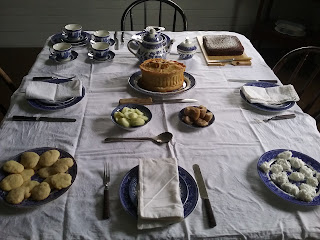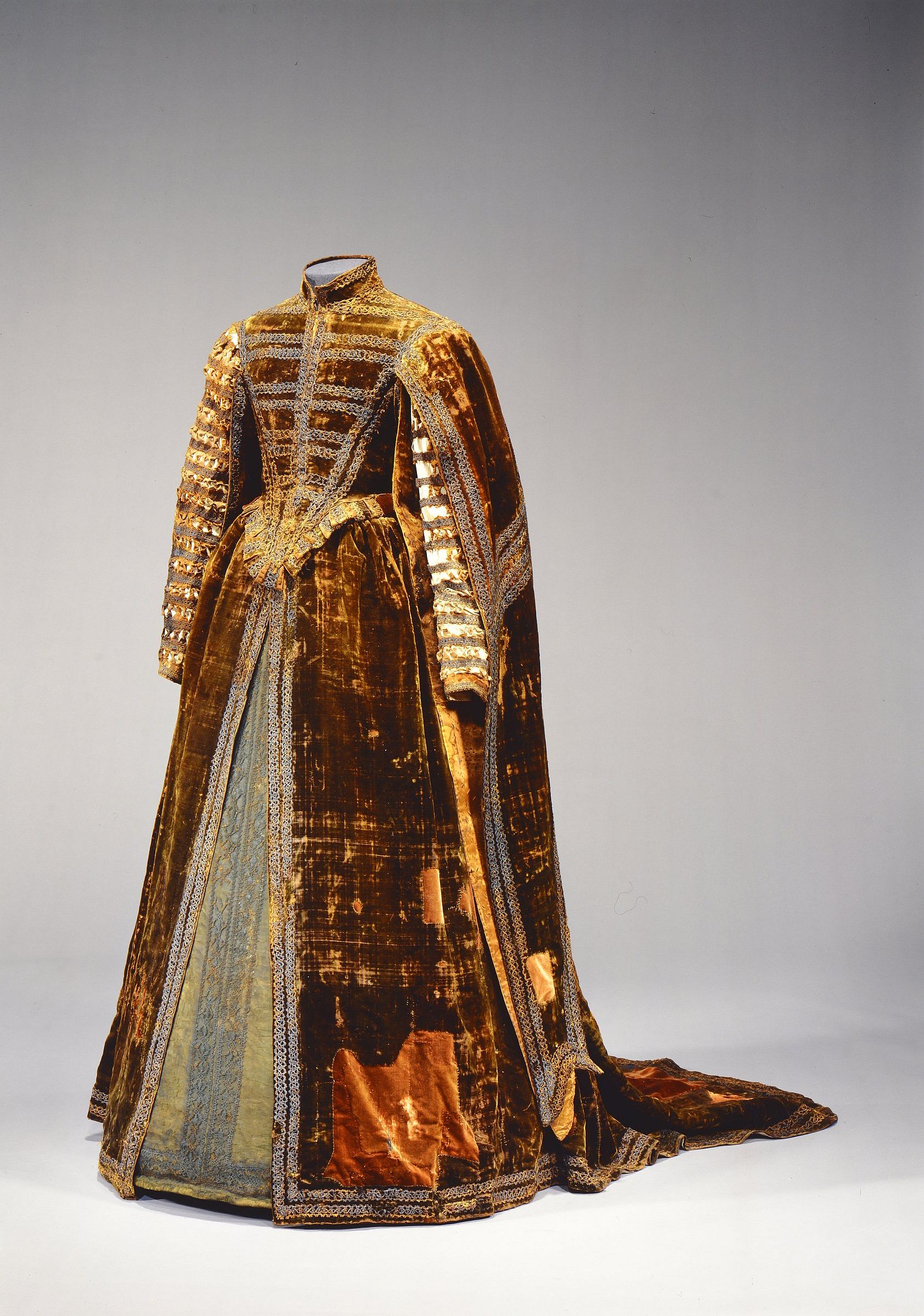Let's take a closer look at early Victorian Christmas foods, as depicted in Charles Dickens's 1843 novella A Christmas Carol.
 |
The Ghost of Christmas Present, on his throne of seasonal delicacies.
|
There are four places in A Christmas Carol where Dickens goes into detail about food served at Christmas. The first, and briefest, is a list of treats served at Fezziwig's Christmas party during Scrooge's youth:
"There were more dances, and there were forfeits, and more dances, and there was cake, and there was negus, and there was a great piece of Cold Roast, and there was a great piece of Cold Boiled, and there were mince pies, and plenty of beer."--Stave II: The First of the Three Spirits
It's worth remembering that this sequence is not set in the story's "present day" (approximately contemporaneous to 1843), but rather at an unspecified point in the past. I've seen adaptations put this c.1790s-1810s, but all we really know for certain is that Scrooge himself was an apprentice--probably in his late teens or early twenties--at the time of Fezziwig's party, which must have been several decades prior to the story's opening.
The other important pieces of context for this moment is that Fezziwig's party it is explicitly a private dance, which logistically lends itself more to a standing supper than a traditional Christmas dinner. The presence of cold meats (both 'boiled' and 'roast') fits well with this service model, while negus is also associated with parties. Furthermore, this is a party being given by a businessman for his family, apprentices, servants, and neighbor's servants. Class distinctions are alive and well in Victorian cookery, and it strikes me that the dishes mentioned here are neither the kinds of cheap food accorded to the very poor nor the especially expensive or impressive dainties laid out to impress middle/upper class guests at an important function. Instead, we're seeing the commonplace luxuries of a middle class family dinner (joints of meat, cake, pie), which would have been rarer treats for the guests at this party, at least one of whom is described as not being fed enough by his employer. The most distinctly Christmas element that I notice here is the mince pies.
The rest of our food descriptions come in during the Ghost of Christmas Present's sequence. He enters the scene with a horn of plenty, surrounded by Christmas decorations, and enthroned on similarly seasonal food:
"Heaped up on the floor, to form a kind of throne, were turkeys, geese, game, poultry, brawn, great joints of meat, sucking-pigs, long wreaths of sausages, mince-pies, plum-puddings, barrels of oysters, red-hot chestnuts, cherry-cheeked apples, juicy oranges, luscious pears, immense twelfth-cakes, and seething bowls of punch, that made the chamber dim with their delicious steam." --Stave III: The Second of the Three Spirits
From their close association with Christmas Present (literally supporting him at his first appearance), these would appear to be the foods that Dickens thinks will most represent the Christmas celebration to his readers. Indeed, the exclusive use of greenery, fires, and food suggests that those
are the most iconic physical objects of his 1840s English Christmases. There aren't religious or recreational accoutrements, presents, stockings, bells, or any of the familiar modern symbols of Christmas accompanying Christmas Present: just food, light/warmth, and foliage. These items not only arrive with the second spirit, but are also named a second time on their departure: "Holly, mistletoe, red berries, ivy, turkeys, geese, game, poultry, brawn, meat, pigs, sausages, oysters, pies, puddings, fruit, and punch, all vanished instantly."
The foods themselves are all seasonal to the middle of winter, including meat, preserved meat products, nuts, shellfish, and hard tree fruit (the easiest fruit to store long-term, along with the citrus which would need to be shipped in from warmer climates). Twelfth cake, in the receipts I've found from this period, tends to be made with dried and candied fruits, which are likewise shelf-stable through this time of the year, while punch frequently features citrus fruit with various alcohols. The foods featured here also also luxurious to some extent: this symbolic and idealized presentation of Christmas feasting doesn't include the bread or vegetables that often accompany the meats (or, in humble circumstances, replace them), but focuses instead on the more aspirational and luxurious seasonal foods: things that would make Christmas meals special or even unique.
Immediately after this apparition, Scrooge and the spirit move into the streets, where the scene description encompasses the gloomy weather and cheerful countenances of the passersby, but also includes the different shops still open for last-minute customers. This third food description focuses on the ingredients being purchased on Christmas itself:
"The poulterers' shops were still half open, and the fruiterers' were radiant in their glory. There were great, round, pot-bellied baskets of chestnuts...There were ruddy, brown-faced, broad-girthed Spanish onions...There were pears and apples clustered high in blooming pyramids; there were bunches of grapes, made, in the shopkeepers' benevolence, to dangle from conspicuous hooks that people's mouths might water gratis as they passed; there were piles of filberts, mossy and brown...there were Norfolk Biffins, squab and swarthy, setting off the yellow of the oranges and lemons, and, in the great compactness of their juicy persons, urgently entreating and beseeching to be carried home in paper bags, and eaten after dinner. The very gold and silver fish, set forth among these choice fruits in a bowl..."
"The Grocers'! ...the blended scents of tea and coffee were so grateful to the nose, or even that the raisins were so plentiful and rare, the almonds so extremely white, the sticks of cinnamon so long and straight, the other spices so delicious, the candied fruits so caked and spotted with molten sugar as to make the coldest lookers-on feel faint, and subsequently bilious. Nor was it that the figs were moist and pulpy, or that the French plums blushed in modest tartness from their highly-decorated boxes, or that everything was good to eat and in its Christmas dress..."--Stave III: The Second of the Three Spirits
These different food stores are the only businesses described in this section: there's no last-minute gift shopping, only last-minute food shopping. Once again, the only tangible product worthy of note at Christmas is the food. The ingredients in the shops are given in more detail and variety than in the previous sequence, though the types are the same: we hear about nuts (chestnuts, filberts, almonds), fruit (pears, apples, grapes, oranges, lemons, raisins, figs, plums), and poultry, now joined by fish, drinks (coffee, tea), spices, confections (candied fruits), and finally a vegetable (onions). All that's missing are the pork products and baked goods. Which I abridged this passage, Dickens's language here is evocative of all the senses, conjuring the color and shape and taste and smell of all these special Christmas foods.
Our fourth and final detailed look at food comes from our introduction to the Crachit household. The material is woven throughout a longer passage describing the family's dress and interactions, but it provides a glimpse of not only what the Crachits were eating, but also how they prepared it (and thus what amenities their house had for cooking):
"Mrs. Cratchit...laid the cloth, assisted by Belinda Cratchit, second of her daughters...while Master Peter Cratchit plunged a fork into the saucepan of potatoes.. And now two smaller Cratchits,boy and girl, came tearing in, screaming that outside the baker's they had smelt the goose, and known it for their own; and, basking in luxurious thoughts of sage and onion, these young Cratchits danced about the table, and exalted Master Peter Cratchit to the skies, while he...blew the fire, until the slow potatoes, bubbling up, knocked loudly at the saucepan lid to be let out and peeled."
"...the two young Cratchits hustled Tiny Tim, and bore him off into the wash-house, that he might hear the pudding singing in the copper."
"Bob...compounded some hot mixture in a jug with gin and lemons, and stirred it round and round, and put it on the hob to simmer, Master Peter and the two ubiquitous young Cratchits went to fetch the goose, with which they soon returned in high procession...Mrs. Cratchit made the gravy (ready beforehand in a little saucepan) hissing hot."
"Eked out by apple sauce and mashed potatoes, it was a sufficient dinner for the whole family; indeed, as Mrs. Cratchit said with great delight (surveying one small atom of a bone upon the dish), they hadn't ate it all at last!"
"...the pudding, like a speckled cannon-ball, so hard and firm, blazing in half of half-a-quartern of ignited brandy, and bedight with Christmas holly stuck into the top."
"The compound in the jug being tasted and considered perfect, apples and oranges were put upon the table, and a shovel-full of chesnuts [sic] on the fire." --Stave III (pages 88-95)
To recap, the entirety of the Crachits' feast is a stuffed goose with gravy, apple sauce, and mashed potatoes, followed by a boiled Christmas pudding. After dinner there's fruit, chestnuts and hot punch (shared in three glasses). The narration that I omitted makes it clear that goose is a rare treat for the family, and that the pudding was very small for the number of people eating.
Interestingly, none of this cooking takes place in a kitchen, or possibly on a stove. The fire in the main room is apparently where most of their cooking takes place: Mrs. Crachit heats the gravy, Peter boils the potatoes, and Bob prepares a festive punch on this heat source, which is called both fire and hob--whether that means a small cook stove, a small heating stove being used for cooking, or a fireplace with some fixture for supporting a saucepan is unclear to me. At any rate, contrary to certain popular adaptations, this cooking area is not sufficient for roasting, baking, or boiling the main menu items. Instead, the goose (stuffed with onion and sage) has been sent out to be baked by a professional, while the pudding is being boiled in the laundry room's copper [basically a proto-water heater: a large, built-in copper vessel over a fire, used to heat water in quantity for washing, etc.]. Both goose and pudding are small, but the Crachits still do not have a designated cooking space that can handle this quantity of food, despite the need to feed at least seven people on a daily basis. Are they routinely boiling their dinners in the copper? Or is their daily hot food limited to the cooking area on the hob? Or, are they among the poor population mentioned in a previous conversation between the Spirit and Scrooge who rely on commercial bakers, and may only eat one hot dinner per week?
We don't get any firm answers to this, though it strikes me that Tiny Tim's miraculous recovery might be related to the family's increased income providing them with better food and the tools they need to cook it.
And that's a wrap. I didn't have a particular research question in mind with this project, but instead wanted to muse over how food is handled in A Christmas Carol. Dickens is very intentional about using food both to give a sense of place, and as a tangible symbol of Christmas itself, which I think has interesting implications for the importance of food to early Victorian Christmas celebrations. It's giving me an idea for a literature review on cooking facilities across class lines...






.jpg)




















